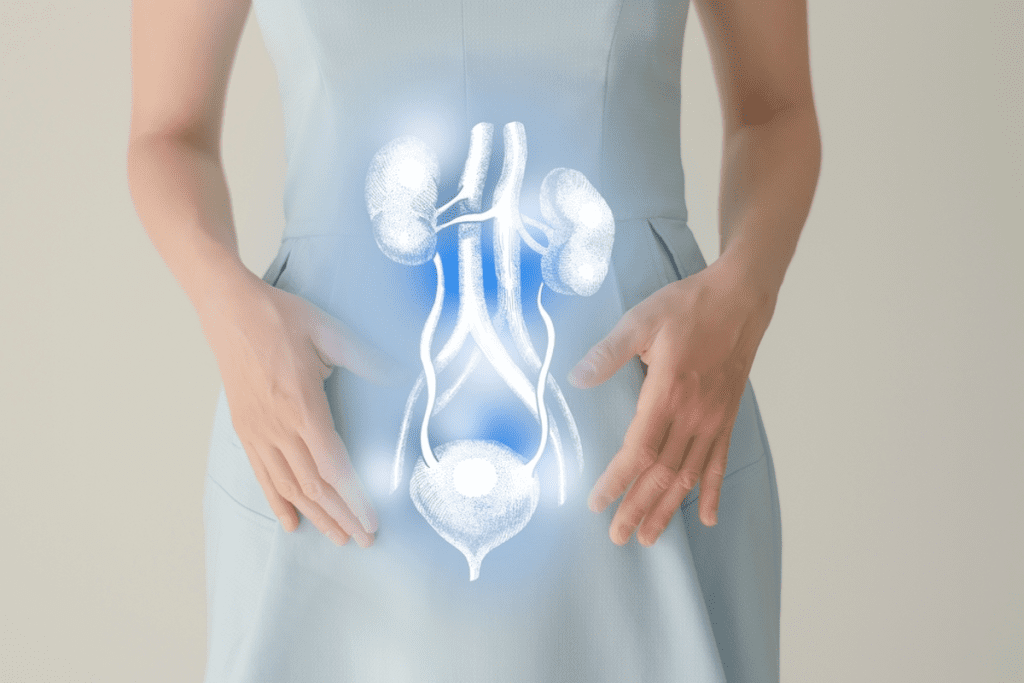Last Updated on October 31, 2025 by
Uro infections can quickly turn into sepsis. Learn how fast it happens and why early care matters.
A urinary tract infection (UTI) can turn into sepsis if not treated. This is a big worry for many. It’s a serious issue, mainly for those at higher risk.

Studies show that up to 30% of sepsis cases start from urinary tract infections. Clinical assessments indicate that urosepsis is a critical issue. It represents a medical emergency that demands immediate attention.
We’ll look into how fast a UTI can become sepsis. We’ll also talk about who’s at risk and why quick medical help is key.
It’s key to know what causes and shows UTIs to stop them from getting worse. UTIs happen when bacteria get into the urinary tract. If not treated, they can cause serious problems like sepsis, as the Sepsis Alliance says.

UTIs start when bacteria get into the urinary tract and grow. The main cause is Escherichia coli (E. coli), which lives in the gut. Other bacteria can also cause UTIs, but E. coli is the most common.
Many things can make you more likely to get a UTI, including:
The signs of a UTI can differ based on where and how bad the infection is. Common signs are:
Knowing what a UTI feels like helps catch it early. Symptoms can be mild or very painful, showing why quick medical help is important.
If a UTI isn’t treated, bacteria can move to the kidneys, causing pyelonephritis. This is a more serious infection. In the worst cases, the infection can get into the blood, leading to sepsis, a very dangerous condition.
Spotting UTI signs and getting medical help fast is key to avoiding sepsis. We stress the need to understand UTIs and their risks to manage and treat them well.
Knowing how fast a UTI can turn into sepsis is key. This can happen in different ways for everyone. It depends on health, age, and how well treatment works.

A UTI can turn into sepsis in hours or days. Studies show sepsis can start in 24 to 48 hours with bad symptoms. This shows why quick medical help is so important.
Some things can make a UTI turn into sepsis faster. These include:
Knowing these risks helps find who needs extra care and treatment.
Case studies show how different people can be. A young, healthy person might get better slowly, giving time for treatment. But an older person with health problems might get sepsis fast.
One case was a patient with acute pyelonephritis, a serious kidney infection. It turned into sepsis in just 24 hours. This shows how fast it can happen and why urgent care is needed.
Pyelonephritis definition is important here. It’s an infection in the kidney. Knowing this helps spot the risk of quick sepsis.
The different rates of getting sepsis show the importance of acting fast when symptoms get worse.
It’s important to know who is at risk for UTI to turn into sepsis. This includes the elderly, young children, and those with health problems. Knowing this helps doctors act fast.
The elderly and young kids are very vulnerable to UTI problems. Older people’s immune systems are weaker, and they might have health issues that make treating UTIs harder. A study on NCBI shows they’re more likely to get sepsis from UTIs because of this.
Young children, under 5, are also at risk. Their immune systems are not fully developed, making them more prone to infections and their complications.
People with diabetes or chronic kidney disease face a higher risk of UTI turning into sepsis. Diabetes weakens the immune system, making it harder to fight off infections. Chronic kidney disease also makes infections more likely because of toxin buildup.
Studies show these people need close monitoring and quick treatment for UTIs to avoid serious problems.
Those who’ve been in the hospital recently are more likely to get UTIs that can lead to sepsis. Hospital UTIs are often caused by stronger bacteria, which are harder to treat. “Hospital-acquired infections, including UTIs, are a significant concern due to the risk of antibiotic resistance,” say doctors.
People with weakened immune systems, like those with HIV/AIDS or on chemotherapy, are more at risk. Their bodies can’t fight off infections well, which raises the chance of sepsis.
It’s key to spot these high-risk groups early. Quick medical care can greatly improve their chances of recovery.
It’s important to know the signs that a UTI is getting worse. This can help you get medical help quickly. A UTI that gets worse can lead to serious problems like acute pyelonephritis or sepsis.
Acute pyelonephritis is a serious kidney infection. It happens when a UTI spreads to the upper urinary tract. Early signs include:
These symptoms mean the infection has reached the kidneys. It needs immediate medical attention. The Sepsis Alliance says catching these signs early can greatly improve outcomes.
When the infection spreads beyond the urinary tract, it can enter the bloodstream. This leads to a systemic infection. Signs of this include:
These signs show the infection is getting worse and could be life-threatening.
If you or someone you know has severe symptoms, get emergency medical care right away:
“Prompt medical attention is key when dealing with serious UTIs. Early action can prevent long-term damage and save lives.”,specialists emphasize.
Knowing what a UTI feels like and when it’s serious can be lifesaving. If you have unusual or severe symptoms, don’t wait to get medical help.
It’s important to know how UTIs can turn into urosepsis. Urosepsis happens when a UTI spreads to the kidneys and gets into the blood.
Bacteria from UTIs can get into the blood in different ways. They usually move up from the lower urinary tract to the kidneys. This causes pyelonephritis, an upper urinary tract infection.
From the kidneys, bacteria can get into the bloodstream. This leads to bacteremia and possibly urosepsis.
“The progression from a localized UTI to urosepsis involves complex interactions between the pathogen and the host’s immune response.” When bacteria get into the blood, they start a body-wide inflammatory response. This is the body’s way of fighting the infection.
The body fights infection with inflammation. When bacteria get into the blood, the immune system releases cytokines and other pro-inflammatory mediators. This can cause symptoms like fever, fast heart rate, and fast breathing.
As The Lancet says, “Sepsis is a life-threatening organ dysfunction caused by a dysregulated host response to infection.” In urosepsis, this can lead to organ failure if not treated quickly.
Uncomplicated UTIs usually stay in the lower urinary tract. They cause symptoms like painful urination and frequent need to urinate. Urosepsis is a more severe form of UTI, where the infection spreads to the blood and can affect many organs.
Knowing the signs of UTI progression and the risk factors for urosepsis is key. Early action can prevent urosepsis and improve patient outcomes.
Antibiotic resistance is a big problem in treating UTIs. It’s important to know how it affects UTI treatment and the possible complications.
When bacteria become resistant to antibiotics, infections get harder to treat. This is a big issue with UTIs. The Centers for Disease Control and Prevention (CDC) have identified antibiotic resistance as a significant threat to public health. We need to use antibiotics wisely and find new ways to treat infections.
Not treating a UTI quickly can lead to serious problems. It can turn into pyelonephritis, a kidney infection. This can be very serious and even life-threatening.
The risk of sepsis, a widespread infection, is also a big worry. This is true for older people and those with weak immune systems.
Choosing the right antibiotic is key in treating UTIs. Urine cultures and sensitivity testing can help guide antibiotic selection. This makes sure the antibiotic works against the bacteria.
It’s also important to finish all antibiotics, even if you start feeling better. This makes sure the infection is gone and helps prevent resistance.
UTI-related sepsis is a serious condition with high mortality rates. It highlights the need for quick medical action. Knowing the prognosis and mortality rates is key for both patients and healthcare providers.
The death rates for UTI-related sepsis depend on how severe it is. Recent data shows a 30-day mortality rate of about 2.8% for urosepsis. But, this rate jumps to 15“20% for severe cases. It can even reach 50“80% if septic shock occurs.
These numbers show how critical early detection and treatment are. We must look at the condition’s severity when judging patient outcomes.
Survival Rate Statistics:
Several factors can impact patient outcomes in UTI-related sepsis. These include:
Understanding these factors helps healthcare providers create treatment plans that meet individual patient needs.
Surviving UTI-related sepsis doesn’t mean no long-term health effects. Some patients may face:
Follow-up care is vital to watch for these long-term effects and manage them well.
Understanding UTIs and their risks is key to avoiding sepsis. We’ve looked at what causes UTIs and how they can lead to sepsis. We’ve also talked about the signs that a UTI is getting worse.
Early detection and treatment are vital for managing UTIs. Using a urinal for urine samples helps diagnose UTIs quickly. Knowing the risk factors and symptoms early can stop complications. Sometimes, doctors may give uro pills as part of the treatment.
Being informed and watchful can lower the risk of sepsis from UTIs. It’s important to see a doctor if symptoms don’t get better or get worse. Quick action can greatly improve health outcomes and prevent long-term problems.
UTI symptoms include mild discomfort and severe pain. You might also have fever and other urinary issues. Knowing these signs is key to catching and treating UTIs early.
The time it takes for a UTI to turn into sepsis varies. It can be a few hours to several days. Factors like age, health, and antibiotic resistance play a role.
Elderly, young, and people with health issues like diabetes are at higher risk. Knowing these groups helps in early treatment.
Serious UTI signs include early pyelonephritis symptoms and systemic infection signs. Severe symptoms need emergency care. Recognizing these can save lives.
Bacteria from UTIs can get into the bloodstream, causing urosepsis. Understanding how the body reacts to infections is vital for managing UTIs and urosepsis.
Antibiotic resistance makes treating UTIs hard. It can lead to complicated infections and sepsis risk. Choosing the right antibiotics is key to managing UTIs and preventing complications.
Mortality rates and prognosis for UTI-related sepsis vary. They depend on the condition’s severity, patient outcomes, and long-term health impacts. Understanding these is essential for effective UTI management.
Preventing UTIs from turning into sepsis requires awareness and early action. Knowing the risk factors and warning signs helps in taking proactive steps to reduce sepsis risk.
Acute pyelonephritis is a kidney infection from a UTI. It’s serious and needs quick medical attention to avoid complications.
Uro pills help manage UTI symptoms like pain. But, they can’t replace antibiotics, which are needed to treat the infection.
UTIs are mainly caused by bacteria entering the urinary tract. Poor hygiene, sexual activity, and certain health conditions can increase the risk.
Subscribe to our e-newsletter to stay informed about the latest innovations in the world of health and exclusive offers!